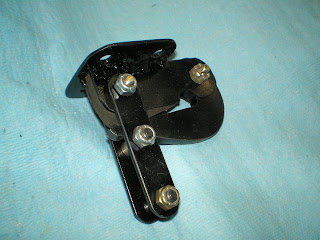
 I've called this a Tail Hook because I don't want people to use it for a glider hook, which is what it's usually called.
I've called this a Tail Hook because I don't want people to use it for a glider hook, which is what it's usually called.I made this one when I was drop-testing a landing gear. The maximum load was about 750 pounds and it handled that without any problems but it wasn't designed to tow a glider. Nor a banner. Or anything else.
 But it does a nifty job of tying your tail down when you start the engine. Indeed, back when I was a kid a glider hook was often found on small planes that called for hand-starting.
But it does a nifty job of tying your tail down when you start the engine. Indeed, back when I was a kid a glider hook was often found on small planes that called for hand-starting.The dimensions of the hook shown here were selected to match the tripod tower I used for my drop tests. But long as the function is not compromised you can make the thing out of just about any material, and of whatever size you need.

After cutting out the pieces I used a MIG welder to attach the side pieces to the mounting plate. With a bit of thought you can see how the side plates could be made from extruded aluminum angle and riveted to an aluminum mounting plate.

Similarly, the two pieces that make up the latching lever could also be fabricated from aluminum. But I think the hook should be made of steel. Not because of any strength issues but because you want the roller to bear against something harder than aluminum.
When installed, ensure the hook can flip all the way open. (See the photo.)







